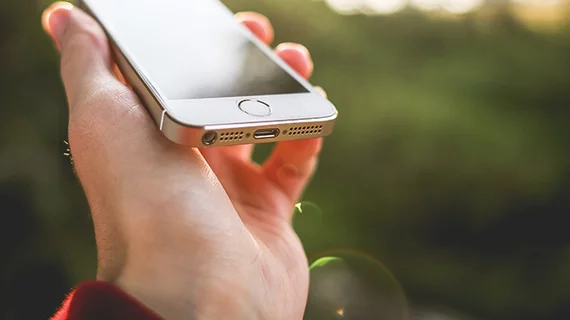Novel iPhone app allows users to measure BP through fingertip
Using existing iPhone features and a novel application, researchers at Michigan State University are exploring whether individuals can measure their blood pressure (BP) simply by pressing a fingertip to the screen.
The research group, led by MSU electrical and computer engineering professor Ramakrishna Mukkamala, PhD, published a proof-of-concept study Sept. 3 in Scientific Reports.
“The user presses her fingertip on both the front camera and screen to increase the external pressure of the underlying artery, while the application measures the resulting variable-amplitude blood volume oscillations via the camera and applied pressure via the strain gauge array under the screen,” the authors explained.
In testing this technique on 20 people, Mukkamala et al. found it produced BP readings within 2 mm Hg of a finger cuff device that is FDA cleared for measuring brachial BP. When analyzed against a standard arm cuff device, the iPhone app yielded bias and precision errors of -4.0 and 11.4 mm Hg, respectively, for systolic BP and -9.4 and 9.7 mm Hg, respectively, for diastolic BP.
Although the application helps guide users’ fingertip placement and actuation, a “try-again” message was prompted in about half of the attempts. Two of the 20 participants were unable to get a BP reading “due to poorly estimated finger pressing contact area,” the authors reported.
Nevertheless, Mukkamala and colleagues remain optimistic this technique, with some improvements, may eventually allow phone users to conveniently and routinely monitor their blood pressure. Frequent measurements could provide a running average that is more accurate than single readings, mitigating the random variability that might arise from fingertip misplacement or other factors, they said.
“By leveraging optical and force sensors already in smartphones for taking ‘selfies’ and employing ‘peek and pop,’ we’ve invented a practical tool to keep tabs on blood pressure,” Mukkamala said in a press release issued by MSU. “Such ubiquitous blood pressure monitoring may improve hypertension awareness and control rates, and thereby help reduce the incidence of cardiovascular disease and mortality.”
According to the release, the researchers believe a smartphone app could be commercially available in late 2019.
“The application still needs to be validated in a standard regulatory test,” Mukkamala said. “But because no additional hardware is needed, we believe that the app could reach society faster.”

